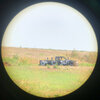These threads always bug me, because they always go the same way.
@MR WICK - posts like yours with this same request come up on one forum or another every week. Honestly, I find it exceptionally unfortunate that SO MANY of the folks like yourself asking the question really don’t accept the answer they’re given. But you’ll put yourself on a path to disappointment if you, like so many others before you - myself included - ignore experienced advice and insist on chasing an objective of finding a cheap spotting scope which reliably allows visibility of bullet holes at 300-500yrds, with or without splatter targets (note: I referenced Shoot-n-c brand of “splatter targets” in my first response). These threads typically end up in the “lead a horse to water, but you can’t make it think” paradigm, unfortunately, and money gets wasted.
On low mirage days, even splatter targets are still tough at 300yrds, and humid days will make 300 futile. I’m not terribly convinced 500 is ever feasible. Recall - service rifle shooters use spotting scopes to see their POI’s at 600 yards, which are plugged with scoring discs as big around as your fist… those disks are used for a reason…
Here’s a thought as to why: A Vortex Viper 20-60x80mm spotting scope has a 15ft minimum FOV at 300yrds, zoomed in at 60x. A 22cal bullet tearing a 1/2” diameter splatter on a target is only 0.2% of the FOV. Comparatively, the 1/4MOA wide reticle line in your scope will cover .79” at 300yrds, meaning it’s ~50% wider than a splatter. It’s not easy to see anything only making up 1/500th of your field of view…
Visually, here are some shots through scopes, binos, and spotting scopes I have on hand:
This is cropped tighter than natural view, because the phone skope app uses full screen fill. Really friendly day, low mirage, only shooting 200yrds with a 22LR, producing splatters about as big as a 223 will produce on a splatter target. This is a 15x magnification optic with exceptional clarity ($2500 Swaro SLC’s), but artificially zoomed even tighter because of the lens cropping. You can see how small bullet splashes appear, even with the strong contrast against the white painted targets.
View attachment 1051786
Alternatively, here are is a 10” gong at 325 yards viewed at 18x through a $300 riflescope - the targets are dirty, but the scope can’t resolve any of the splatter at that distance - the contrast isn’t clean enough in the high sun to discern the impact splashes from the paint.
View attachment 1051800
Here’s a 400-450 yard target array viewed through a 20-60x85mm spotting scope with a $1500 street price. Mirage is gross, targets are ~9”x12” heads, bullet splatters are somewhere around 1-1.5” diameter… can’t resolve impacts on target worth a damn here.
View attachment 1051804
THIS is why so many of us warn others to NOT buy a spotting scope with the expectation of seeing bullet holes at 300 and beyond. On the best of days, it ~kinda~ works at 0-200, 300ish. On most days, it really doesn’t work at 300 and beyond. And on almost any day, it doesn’t work at 500.










